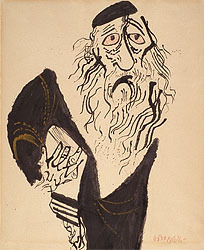FOCUS IN/ON - William Gropper
The Warsaw Ghetto: A Brief Description

William Gropper, 1897-1977 The Wanderer, c. 1960 Ink with wash on paper, 16" x 14" Hillstrom Museum of Art, gift of Reverend Richard L. Hillstrom ('38)
Earlier, on April 19, 1943, an astonishing event had taken place: Jews imprisoned in the Warsaw Ghetto rose up against their Nazi oppressors and staved off deportation to death camps for almost a month. This revolt was astonishing not because the Jews of Europe, marked for destruction by the Third Reich, had not resisted before-they had on many occasions-but because such resistance was truly a David and Goliath story.
When the Nazis invaded Poland on September 1, 1939, thereby initiating World War II, 30% of the population of Warsaw, the capital city, was Jewish. Almost immediately, these Jews were forced to wear an armband with a blue Star of David, and were subject to a variety of forms of discrimination. A year later, the Nazis established the Warsaw Ghetto by building a ten-foot wall around a 1.5-square-mile area of the city. A half a million Jews were then forced to leave their homes and live in crowded, unsanitary conditions with a diet intentionally devised by the Nazis to insure starvation. Each month, 5,000-6,000 ghetto inhabitants died of disease, hunger, hypothermia, and shootings.
In the summer of 1942, when the Holocaust was at its height, 300,000 Jews were deported from the Warsaw Ghetto to nearby Treblinka, a killing center. Though told they were being "resettled in the East," these Jews were usually dead from gassing within a few hours of their arrival at Treblinka. Reports of these deaths leaked back to the ghetto and thus was founded the ZOB, or the Jewish Fighting Organization (Zydowska Organizacja Bojowa), a secret resistance force. In the spring of 1943, rumors of an impending deportation spread through the ghetto and the ZOB-755 fighters strong-immediately moved into action.
One of these fighters was a woman named Vladka Meed, who has told her story in a gripping memoir titled On Both Sides of the Wall. Meed recounts how she and others, over the months, slipped out of the ghetto in work details or through the sewers. Reaching the "Aryan" side of the ghetto wall, they would then organize guns and the ingredients for Molotov cocktails and smuggle them back into the ghetto to be hidden away until needed.
That day came on April 19, 1943. The ZOB recognized that the well-equipped Nazis would eventually overcome their resistance; but the motto of the ZOB was "All are ready to die as human beings." They had agreed that a death on their own terms, demonstrating the courage of the imprisoned Jews, was preferable to a Nazi-engineered extermination. For almost a month, the resistance held out and succeeded in killing several Nazis. However, on May 16, the revolt came to an end. Nazi officer Jurgen Stroop had commanded that the Great Synagogue of Warsaw be torched and that the ghetto be systematically burned down, block by block. Many members of the ZOB died in the ensuing fighting and fires; others were captured and sent to Treblinka to their deaths.